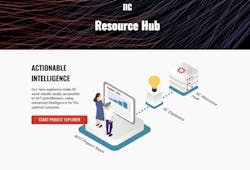The biggest hurdle for many companies when it comes to the Industrial Internet of Things (IIoT) is not just the well-known connectivity or security issues. Equally as daunting, if not more so, is deciding where to start with IIoT in a way that makes the most sense for the company.
To help companies navigate this decision process, the Industrial Internet Consortium (IIC) announced during its annual Internet of Things Solutions World Conference (IoTSWC) the development of the IIC Resource Hub—a new online interface to the organization’s resources—and a web-based tool called IIoT Project Explorer that is designed to guide users through the analysis and planning of their own IIoT projects.
Referencing IIC foundational documents, testbed insights, toolkits, demos and relationships with global standards and industry groups, the IIC Resource Hub is designed for use across industries by both technical and business stakeholders, says the IIC.
“Members of the IIC have developed these resources for the industry so project managers and system architects don’t have to rely solely on intuition and prototyping in unchartered territory as they do today," said Dirk Slama, vice president of business development at Bosch Software Innovations and chair of the IIC Steering Committee. "The IIC Resource Hub will help lead to successful IIoT implementations and facilitate the multi-billion dollar opportunities of the IIoT.”
Three components comprise the IIC Resource Hub:
- The IIC Body of Knowledge contains collaborative resources that have been developed, tested and published by industry leaders from the IIC membership. The resources include testbed overviews and outcomes, Insight Reports, white papers and IIC foundational documents, which encompass the Industrial Internet Reference Architecture, Industrial Internet Security Framework, Industrial Internet Connectivity Framework, Business Strategy and Innovation Framework, Industrial Internet of Things Analytics Framework, and Vocabulary Technical Report. All of this content is interlinked on the site so users can see where member and external companies are aligned with IIC projects.
- The IIoT Project Explorer is an artificial intelligence-based online system for creating an assessment of an IoT project. It enables users to scope a solution and create a mutual basis for communication between technical and business project stakeholders by directing a quantitative method for developing project implementation, rollout and growth plans. The IIoT Project Explorer guides users through IIoT project management by asking a series of questions to ensure they understand the complexity of the project and do not forget anything, according to Soley. He added that the IIC doesn't have access to the data that users input into the system to receive project guidance. “The data is stored locally on your browser and remains under your control,” Soley said. Bill Hoffman, president of the IIC, said the AI system supporting the IIoT Project Explorer was built specifically for the IIC in a joint project between U.S. and German integration firms. It took 18 months to build at a significant investment in order to deliver the type of functionality the Consortium was aiming for, Hoffman said.
- Ecosystem Directory is a mapping of the IIoT ecosystem that categorizes products, services, researchers and end users. Users can search for experts based on the type of expertise sought.
Results from the Resource Hub’s reports will show where users stand with regard to operations technology, information technology, and system and project environment aspects. "This information can be helpful in generating RFPs for your project—and a draft RFP is provided as a download," Slama said. "The Resource Hub helps manage your risks in an IoT project and gives recommendations for further reading on targeted content in the Resource Hub,”
The IIC said other Explorer tools currently under development will provide additional assistance with maturity modeling, security assessment and interoperability challenges.
About the Author
David Greenfield, editor in chief
Editor in Chief

Leaders relevant to this article:
